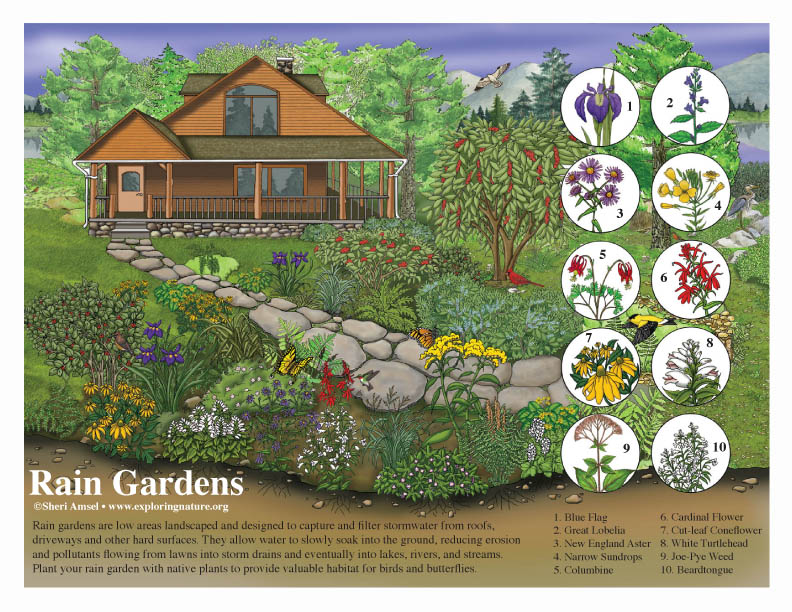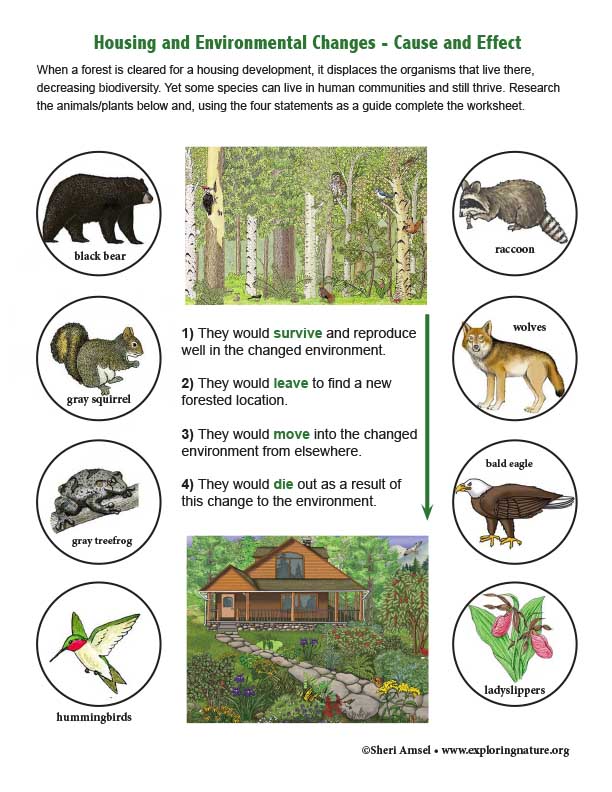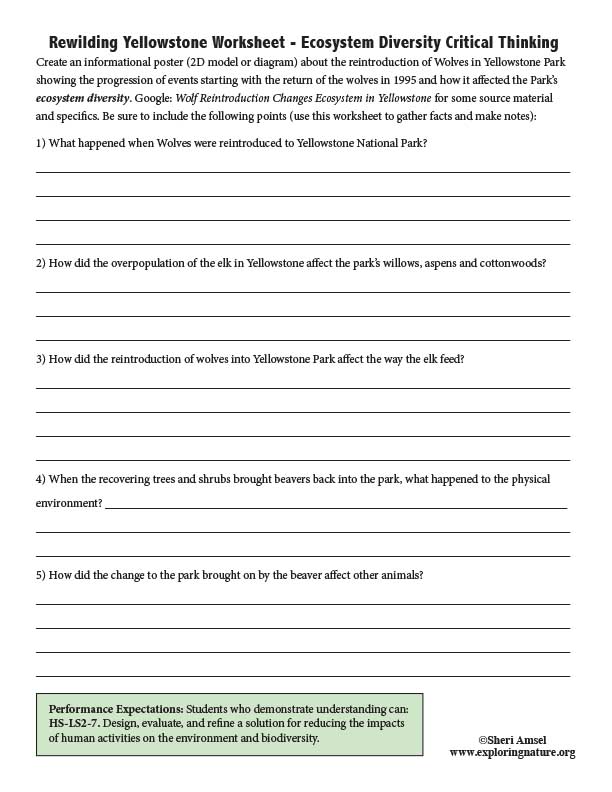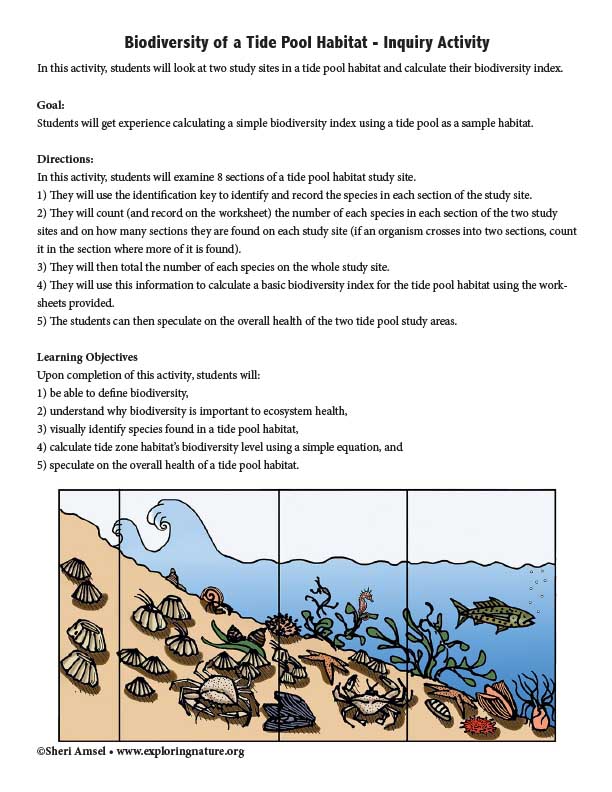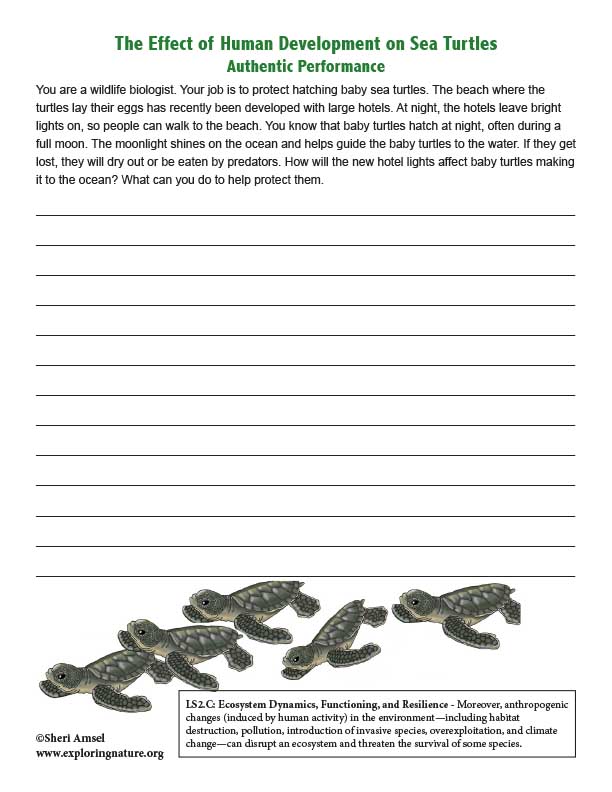

Disciplinary Core Ideas
LS4.D: Biodiversity and Humans
• Biodiversity is increased by the formation of new species (speciation) and decreased by the loss of species (extinction). (secondary to HS-LS2-7)
• Humans depend on the living world for the resources and other benefits provided by biodiversity. But human activity is also having adverse impacts on biodiversity through overpopulation, overexploitation, habitat destruction, pollution, introduction of invasive species, and climate change. Thus sustaining biodiversity so that ecosystem functioning and productivity are maintained is essential to supporting and enhancing life on Earth. Sustaining biodiversity also aids humanity by preserving landscapes of recreational or inspirational value. (secondary to HS-LS2-7) (Note: This Disciplinary Core Idea is also addressed by HS-LS4-6.)
LS2.C: Ecosystem Dynamics, Functioning, and Resilience
• Moreover, anthropogenic changes (induced by human activity) in the environment—including habitat destruction, pollution, introduction of invasive species, overexploitation, and climate change—can disrupt an ecosystem and threaten the survival of some species.
ETS1.B: Developing Possible Solutions
• When evaluating solutions it is important to take into account a range of constraints including cost, safety, reliability and aesthetics and to consider social, cultural and environmental impacts. (secondary)
Crosscutting Concepts
Stability and Change
• Much of science deals with constructing explanations of how things change and how they remain stable.
Science and Engineering Practices
Constructing Explanations and Designing Solutions
Constructing explanations and designing solutions in 9–12 builds on K–8 experiences and progresses to explanations and designs that are supported by multiple and independent student-generated sources of evidence consistent with scientific ideas, principles, and theories.
• Design, evaluate, and refine a solution to a complex real-world problem, based on scientific knowledge, student-generated sources of evidence, prioritized criteria, and tradeoff considerations.
Performance Expectations:
Students who demonstrate understanding can:
HS-LS2-7. Design, evaluate, and refine a solution for reducing the impacts of human activities on the environment and biodiversity.* [Clarification Statement: Examples of human activities can include urbanization, building dams, and dissemination of invasive species.]
____________________________________________________________________________________________________________
Biodiversity and Humans
Biodiversity is the rich variability among living organisms. This includes organisms that live in all ecosystems - on land, in the ocean, in freshwater habitats, underground, and even those managed by humans – agricultural crops, nature preserves, national and urban parks. Biodiversity increases with the formation of new species – speciation and is decreases by the loss of species - extinction.
Biodiversity is important for many reasons:
1) A diverse biological community helps keep an ecosystem healthy with stable populations, food webs and the ability to survive changes.
2) Stable ecosystems benefit humans as they provide resources that have a financial value – foods, medicines, energy, recreation, and tourism.
3) Biologically, diverse, stable habitats also benefit humans with what some scientists call ecological services. These are not easy to put a price tag on, but without them humans cannot survive on Earth. They include nutrient cycling, soil development, decomposition, oxygen production, carbon dioxide absorption, and carbon storage, among other things. The more biodiversity in an ecosystem, the more ecological services it provides. Losing these ecological services will eventually affect humans in ways we cannot ignore.
Biodiversity is complex. It is most often broken down in three ways:
1) the number of different species or species diversity in an ecosystem,
2) the genetic variability within a population of species or genetic diversity, and
3) the variability and distribution of species throughout a whole ecosystem - ecosystem diversity.
There are many threats to biodiversity created by humans (anthropogenic changes). As our population grows, we see an increase in habitat destruction, over harvesting of habitat resources, overfishing of marine and freshwater fisheries, an increase in tourism – which can lead to habitat damage, introduction of invasive species which can out compete native species, an increase in pollution, and over all growing climate change. Humans are working to develop ways to address these issues in their communities and around the world to preserve a rich, vital, and healthy planet for generations to come. One way to play a role in this important process is to understand biodiversity, the reasons it is important, the things that threaten it, and the ways we can try to mitigate it over time.
l. Species Diversity
Biodiversity is the number of different species in a biological community – which can be as small as the organisms living in a single tree or a whole forest biome. This is also referred to as species richness.
Rainforests have always been held up as the ecosystem with the most species diversity, though not all the species have even been identified yet in these rich habitats. In addition, through photosynthesis, rainforests absorb massive amounts of carbon dioxide, which helps offset the effects of climate change, and release lots of oxygen that circulates around the planet. Scientists estimate that rainforests provide between 10-20% of all the oxygen on Earth. Like a great green sponge, rainforests also absorb and release water, keeping the local climates moist with regular precipitation and healthy aquifers. The regular cycling and decomposition of leaves and other organic matter keeps the soil rich and healthy for the continued growth of massive trees. Rainforests are a great resource for foods, medicines, and timber. These are just some of the rainforests’ huge value in ecological services to humans.
Sadly, rainforests are also experiencing the fastest growing destruction of any habitat - so called anthropogenic changes. They are harvested for wood and other resources or simply burned and converted into agricultural land. In 2019, scientists identified more than 74,000 fires burning in the Amazon Rainforests of South America. As the rainforests burn, the regions loses it ability to absorb carbon dioxide and instead is adding more carbon to the atmosphere - increasing greenhouse gases instead of helping to counter it. In addition, the moisture holding affect of the forests is lost and the region becomes drier, which increases the likelihood of more fires.
Habitat loss has a major affect on biodiversity and species richness and it’s not just rainforests that are affected. Habitats of all kinds around the world are being destroyed as our world population grows. Plowed and developed prairies, drained wetlands, and clearcut forests leave only small isolated pieces of natural communities that can’t support healthy, stable populations. This puts them at huge risk, because they lack the rich biodiversity of species that create the healthy, complex, organization of a working ecosystem. Reducing the impacts of human activities on the environment and on biodiversity will become more vital over time as our population continues to rise, world resources dwindle, and climate change increases.
ll. Genetic Diversity
The genetic variability within a species is important to understand as well. A population is any group of the same species that lives in one location together, such as herd of caribou. All populations, even though they are the same species, have some genetic variability. This allows them to survive change – whether is it from disease, climate change, scarcity of food or predator pressures. Generally, the larger the population of organisms, which have more genetic variability, the lower the risk.
For example, a herd of caribou is a population of animals that are all the same species, but have some genetic variability. This variation may show up in the form of various traits, such as longer legs (that might help them escape from predators), larger antlers (to defend themselves from predators and compete for a mate), bigger, hairier feet (that would help them save energy by being able to run across the snow without breaking through) or thicker fur (to help stay warm). Any of these traits might lead to a longer life.
If a trait helps an animal survive, it is called an adaptive trait. Adaptive traits can help an animal find food, make a safer home, escape predators, survive cold, heat or lack of water. A caribou with a longer life can produce more young over its lifetime. Some of their helpful adaptive traits are passed onto their young. These are called inheritable traits and will help their young survive and have more young of their own. Over time, more and more of the caribou in this population will inherit these adaptive traits. This is called differential reproduction.
Changes in a population through differential reproduction, which helps the group survive, is an example of natural selection. Natural selection can lead to the adaptive traits showing up in more and more of a population as time goes by, making the herd stronger and increasing its chance of survival over time. This is the powerful result of genetic variability.
Natural selection can also lead to speciation. For example, if one group of caribou got separated from the herd (e.g. on an island), over thousands of years, natural selection might result in so many changes that they develop into a new species. This is called speciation. Speciation takes a long time and is much less common than extinction.
lll. Ecosystem Diversity
The variability and distribution of species throughout a whole ecosystem is genetic richness on a larger scale. This kind of biodiversity is harder to measure as it is affected by:
a) how many different communities are in the area – a community is many different populations of species living in one area and interacting with each other and the physical environment,
b) how big they are,
c) their distribution, and
d) how they are interacting with each other.
Many of the different populations of organisms in a community affect each other in ways that might not be readily apparent. Losing one species may well affect the other populations in the community. For example, The American alligator, found in freshwater habitats of the southeastern U.S., was once thought to be a dangerous pest. Fishermen thought they were eating all the game fish. They were hunted so aggressively, that by 1965, they became an endangered species on the verge of extinction. Then, as the alligators disappeared, people began to notice that instead of better fishing, all the game fish were disappearing. Biologists confirmed that the alligators’ favorite prey, a large fish, called a gar, had been having a population boom. With no alligators to eat them, the gar numbers were rising and they were eating all the game fish. The loss of the alligator had changed the delicate balance of that ecosystem. Biologists call the American alligator a keystone species, because it has a major influence in balancing its ecosystem’s biodiversity.
Ecosystem diversity also takes into account the physical environment. When wolves were reintroduced into Yellowstone Park, they reduced the elk population, which had overpopulated the park and eaten back all the willow, aspen and cottonwoods. The wolves also kept the elk herds moving so they could not over browse any one area. In just a few years, the trees came back and then the beaver returned. The beavers created dams and changed the waterways. This created habitat for more fish, waterfowl, songbirds and other animals. In a relatively short period, Yellowstone Park’s physical environment had changed, its ecosystems had become more robust and the biodiversity had increased. Reintroducing apex predators, like the Yellowstone wolves, to restore sustainable diversity to an ecosystem is called rewilding. See the Rewilding Yellowstone Worksheet - Ecosystem Diversity Critical Thinking to create a 2D model of this successful example of biodoversity recovery.
Rain Gardens - Protecting Waterways - Design Project
When building houses and paving roads, driveways and sidewalks, we create pathways for litter, debris and pollutants to run off into storm drains, rivers and lakes. This can also cause erosion that damages infrastructure. One solution that is gaining traction with some developers is the creation of rain gardens. Rain gardens are low lying areas landscaped and designed to capture and filter storm water and allow it to slowly soak into the ground. This reduces erosion, street flooding, and pollutants (from roofing shingles, asphalt, fertilized lawns, septic systems, etc.) from flowing into waterways. It can also reduce the cost of installing expensive drainage systems in new developments. Planted with native species, rain gardens can provide important habitat for birds, butterflies and other insects and be a pretty addition to a community (or school yard).
Design a potential rain garden for your community or school. Here are some ideas. Do some research online into other rain gardens build by communities around the country (or world). Consider a location that is slightly lower than housing and paved areas, but not too close to a wetlands or waterways. You can use google maps to look for a likely spot on town or school land or near where you live (not on private property). When designing the shape and look of your rain garden, choose native plants that will benefit local wildlife. Draw a map overview of its location and design.
For some step by step directions: LINK
Green Home Building Activity
You have purchased a piece of forested land on which you plan to build a house. The forest is home to a diverse community of animals and plants that will be affected by your construction. Think of ways that you can create a comfortable home while minimizing the impact on the forest’s biodiversity. Consider home construction space and materials, energy use, landscaping options to reduce mowing, water use, fertilizer use, and pesticide use, waste removal, etc. Write out some ideas for your future home before developing a large diagram of your future home and yard. See the How Do Humans Affect their Environment When Building New Houses diagram for ideas.
Housing and Environmental Changes - Cause and Effect
When a forest is cleared for a housing development, it displaces the organisms that live there, decreasing biodiversity. Yet some species can live in human communities and still thrive. Research the animals/plants below and, using the four statements as a guide complete the worksheet.
1) They would survive and reproduce well in the changed environment.
2) They would leave to find a new forested location.
3) They would move into the changed environment from elsewhere.
4) They would die out as a result of this change to the environment.
Predict how developing a forested area into housing will affect some species of living things.
1) Speculate what would happen to each as a result of this changed environment.
2) Suggest some ways to make development less harmful to populations of wild organisms.
3) Share a memory about a wild animal you’ve seen in the community where you live and how it made you feel.
Turtles and Environmental Changes - Authentic Performance
You are a zoologist and curator for a wild animal park that features a large pond with several species of turtles. The landscaping department wants to replace the sandy banks around the pond with a decorative rock garden covered in a thick layer of pretty stones and sculptures. Using what you know about how turtles reproduce, how would this change to the turtles’ environment affect their life cycle? If they decide to make the change, would you expect ot affect the population of turtles in the exhibit over time? How might it affect the population of fish in the pond that the turtles eat?
Rewilding Yellowstone Worksheet - Ecosystem Diversity Critical Thinking
Create an informational poster (2D model or diagram) about the reintroduction of Wolves in Yellowstone Park showing the progression of events starting with the return of the wolves in 1995 and how it affected the Park’s ecosystem diversity. Google: Wolf Reintroduction Changes Ecosystem in Yellowstone for some source material and specifics.
Biodiversity of a Tide Pool Habitat - Inquiry Activity
Biodiversity is the number of different species in a biological community – which can be as small as the organisms living in a single tree or a whole forest biome. This is also referred to as species richness. In this activity, students will look at two study sites in a tide pool habitat and calculate their biodiversity index.
Protecting Coral Reefs - Design a Solution
Our coral reefs are in trouble. Poachers harvest the colorful corals and fish to sell to collectors. Boaters dump trash or dirty water (bilge) too close to reefs and sometimes anchor on the fragile coral itself. Snorkelers walk on the fragile coral and use dish soap to rinse out scuba masks right in the water (to reduce fogging), exposing reef species to harmful detergents. Excessive tourism can also affect the normal feeding and reproduction of species on coral reefs. What can do to protect this vital habitat?
Research if there has been any legislation passed to protect coral reefs. Suggest some regulations, conservation, and educational options, etc, that might help with coral reef protection. Consider how any conservation plan might affect tourist businesses (e.g. Suggesting that we halt all tourist trips to coral reefs is probably not reasonable.). How will you implement your plan? Take some notes below, then write up a proposal or letter to the editor or your legislator or develop an educational poster, brochure, etc. or create an educational meme for social media.
You are a wildlife biologist. Your job is to protect hatching baby sea turtles. The beach where the turtles lay their eggs has recently been developed with large hotels. At night, the hotels leave bright lights on, so people can walk to the beach. You know that baby turtles hatch at night, often during a full moon. The moonlight shines on the ocean and helps guide the baby turtles to the water. If they get lost, they will dry out or be eaten by predators. How will the new hotel lights affect baby turtles making it to the ocean? What can you do to help protect them.
When you research information you must cite the reference. Citing for websites is different from citing from books, magazines and periodicals. The style of citing shown here is from the MLA Style Citations (Modern Language Association).
When citing a WEBSITE the general format is as follows.
Author Last Name, First Name(s). "Title: Subtitle of Part of Web Page, if appropriate." Title: Subtitle: Section of Page if appropriate. Sponsoring/Publishing Agency, If Given. Additional significant descriptive information. Date of Electronic Publication or other Date, such as Last Updated. Day Month Year of access < URL >.
Amsel, Sheri. "HS-LS2-7 Ecosystems: Interactions, Energy, and Dynamics" Exploring Nature Educational Resource ©2005-2024. December 13, 2024
< http://www.exploringnature.org/db/view/HS-LS2-7-Ecosystems-Interactions-Energy-and-Dynamics >




